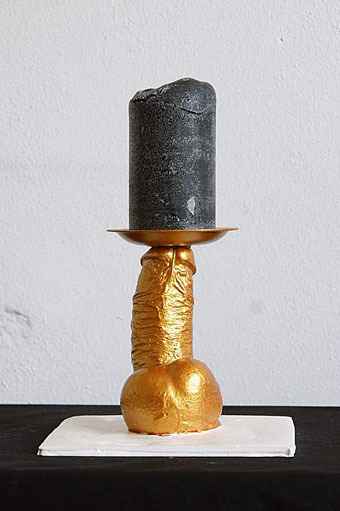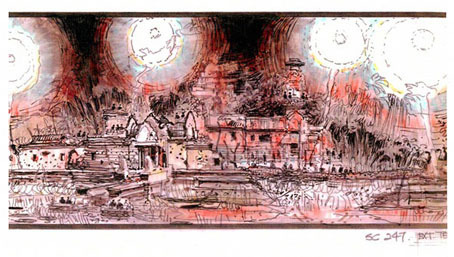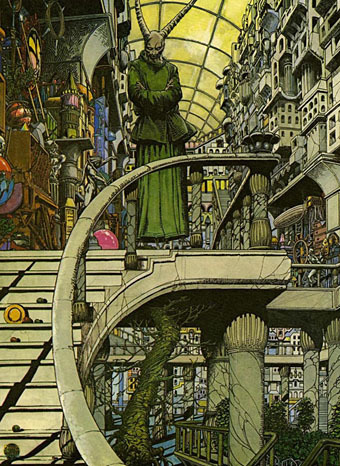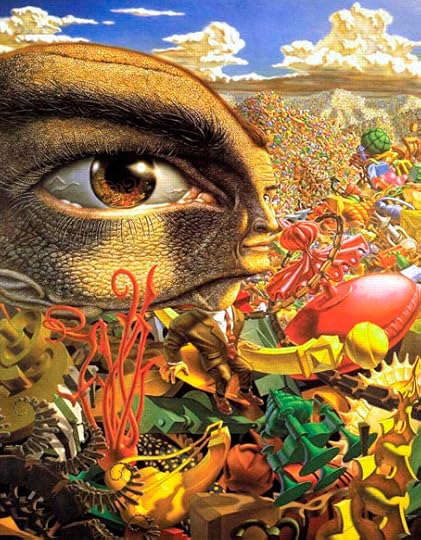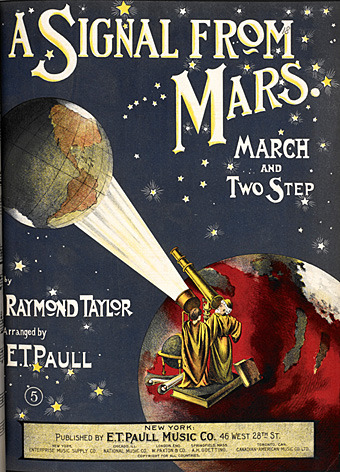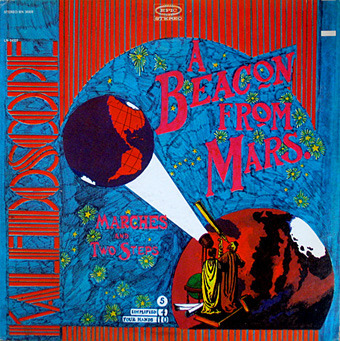John Coulthart's Blog, page 309
May 25, 2011
Bookplates from The Studio
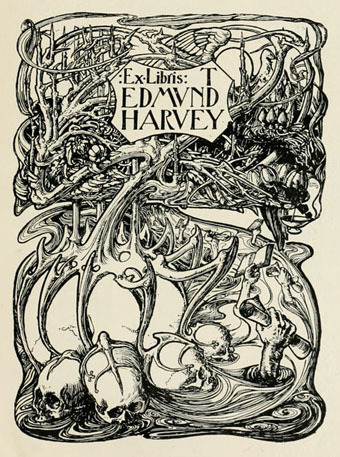
Cyril Goldie.
Selections from Modern Book-plates and their Designers, an overview of British, American and European designs published by The Studio magazine in 1898. These small Studio books are always good to see, not least for the period ads in the opening and closing pages. A couple of the designs are familiar from later reprints, notably Cyril Goldie's remarkable accumulation of thorns and skulls. Many others are in the swirling and tendrilled style of Art Nouveau which The Studio did much to promote in Britain. Also of interest are a few entries from well-known fine artists who are seldom associated with this kind of design. Among these is Belgian Symbolist Fernand Khnopff who contributes a design of his own and an article about Flemish bookplate design.
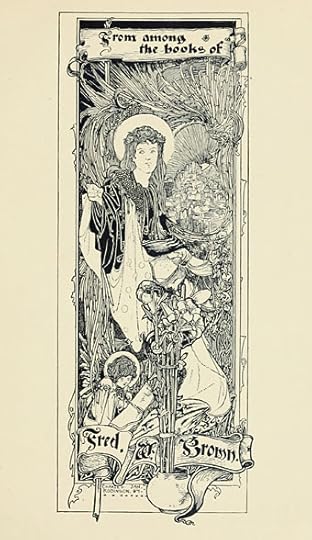
Charles Robinson.
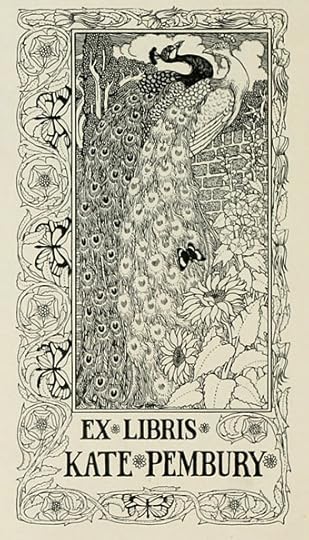
PJ Billinghurst.
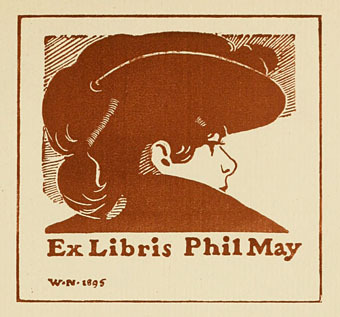
A bookplate by one artist for another, the design is by William Nicholson for caricaturist Phil May.
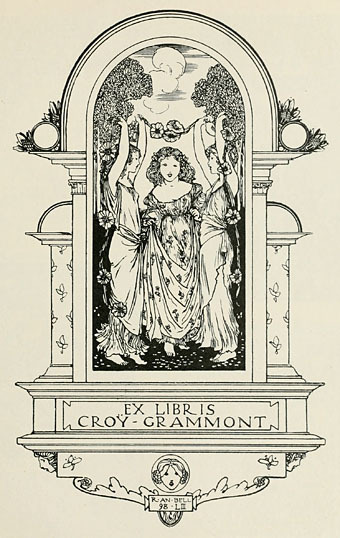
Robert Anning Bell.
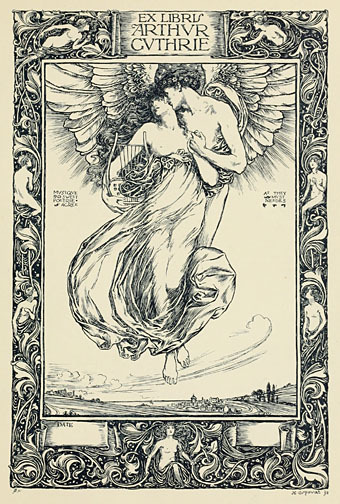
H. Ospovat.
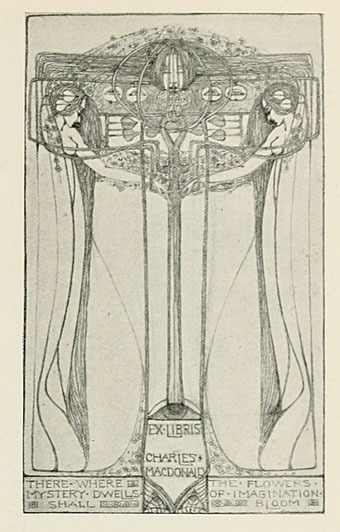
Margaret McDonald.
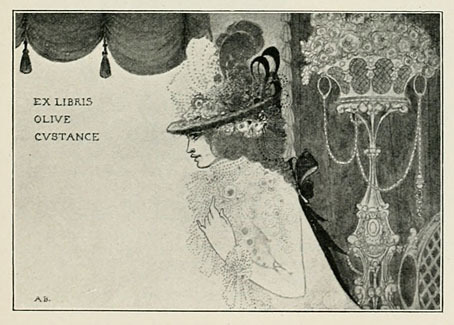
A bookplate by Aubrey Beardsley which is seldom seen outside very extensive collections of his work.
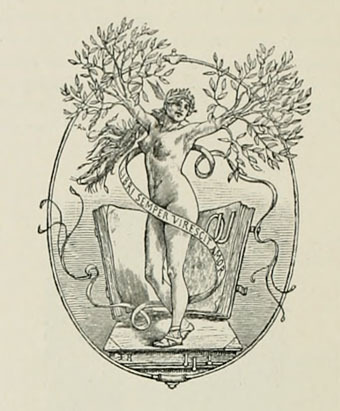
Not a very notable entry apart from being the work of the notorious Félicien Rops.
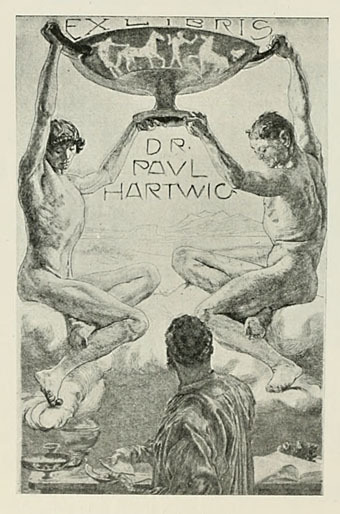
Max Klinger.
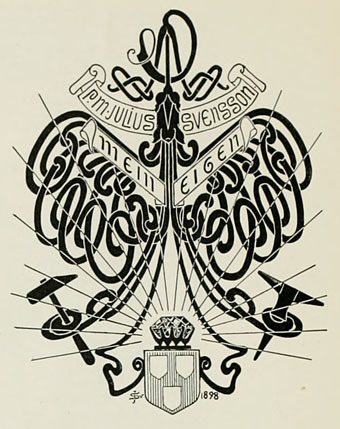
Julius Svensson.
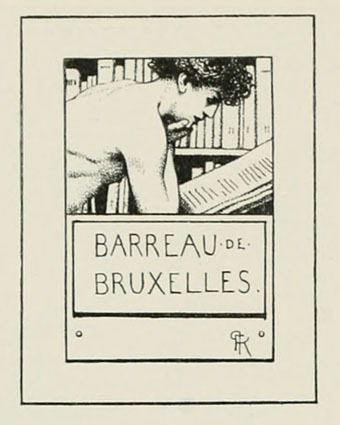
Fernand Khnopff.
Previously on { feuilleton }
• Yuri Yakovenko bookplates
• Tranquillo Marangoni bookplates
• Book-plates of To-day
• Louis Rhead bookplates
• Pratt Libraries Ex Libris Collection
• The Evil Orchid Bookplate Contest
• The art of Oleg Denysenko
• David Becket's bookplates
May 24, 2011
Passage 15
Directing your attention elsewhere again today, to the latest edition of Passage the Dutch webzine run by my good friend Ed Jansen. Number 15 is described thus:
Passage 15 is, with a few exceptions, entirely devoted to art. Images govern our lives, literally and figuratively. Gaudier-Brzeska nearly a hundred years ago and Antony Gormley today affect our way of looking. Odd Nerdrum does so with his painting on a very different way. The music of Polly Jean Harvey made us curious about her sources of inspiration. The piece about Gallipoli is actually a kind of enormous footnote to her latest cd "Let England Shake". The photo section provides an overview of exhibitions and performances in the past few months in and around The Hague, Netherlands.
Seeing Gaudier-Brzeska's sculptures reminds me that I haven't seen Ken Russell's film of the artist's life, Savage Messiah, for many years. The large Antony Gormley work on the cover (Exposure) makes a welcome change from the artist's cast-iron clones. I'm still waiting for Gormley to create the Ejaculating Man, a seawater-spurting statue he proposed for Seattle. It was rejected, of course, and it's difficult to imagine any American city exhibiting something of that nature given the current climate. Maybe he should try Amsterdam.
Back at Ed's work, his varied Flickr stream includes some recent views of Futuro, a mobile holiday home designed by Matti Suuronen in 1968. What was once futuristic now has a Jetsons-like retro glamour.
Previously on { feuilleton }
• Passage 14
• Passage 13
• Passage 12
• Passage 11
• Passage 10
May 23, 2011
Lovecraft's favourite artists revisited
HP Lovecraft (1937) by Virgil Finlay.
I was asked recently to join the bloggers at Tor.com writing about art as it relates to fantasy and science fiction, so for today's post your attention is directed to this piece, an expanded version of a rather half-hearted list I put together a few years back concerning HP Lovecraft's favourite artists. Half-hearted or not, people kept linking to that list so it seemed a good idea to make more of it. I'll be writing these posts a couple of times a month, provided I have the time to do something worthwhile. Watch this space.
Previously on { feuilleton }
• The monstrous tome
May 22, 2011
Phallic casts
After the phallic parades of a couple of weeks ago, here's something a bit more contemporary. Artist Jos Karis works under the name Josephtailor creating a variety of sculptural pieces in different media. Among the examples on his website there's what appears to be a papier-mâché torso covered with a collage of gay porn pictures, and also a series of penises cast from plaster. The phallic works immediately bring to mind the penis memorials of Cynthia Plaster Caster, famous (notorious, even) for preserving in plaster form the erect members of notable musicians. Josephtailor's casts seem to be anonymous (his site is short on detail) but he makes more of the end result. Cynthia has also made casts of women but not enough to create a Great Wall of Vagina like British caster Jamie McCartney. One of the contributors to McCartney's wall was Ms Hayley Campbell who discussed the experience here. (Thanks to Paul for the Josephtailor tip!)
Elsewhere on { feuilleton }
• The gay artists archive
Previously on { feuilleton }
• Return of the Triumphant Phallus
• The Choise of Valentines, Or the Merie Ballad of Nash His Dildo
• The fascinating phallus
• The Triumph of the Phallus
• Le Phallus phénoménal
• Phallic bibelots
• The New Love Poetry
• Phallic worship
• The art of ejaculation
May 21, 2011
Weekend links: Apocalypse not now
The Kurtz compound prior to destruction. An Apocalypse Now storyboard, one of a number which will be included among the extras on the Blu-Ray release of Francis Coppola's film when it appears in the UK next month. The film is given a new cinema release on May 27th.
Radio broadcaster Harold Camping, a man denounced by fellow Christians as a false prophet, achieved one thing at least this week by making himself and his followers a global laughing-stock after the Rapture failed to materialise. I would have put money on him blaming those terrible gays somewhere along the way, such complaints being so common among a certain brand of American fundamentalist that you could write their sermons for them. Sure enough, here's the old fool blathering about "lespianism" and describing the beautiful city of San Francisco as a cesspool. Shall we chalk this up as another victory for the gays, Harold? Related: No dogs go to heaven.
The internet has always been a home for ridicule but occasions like this bring out the wags in droves. The Oatmeal showed us how God is managing the Rapture using a Windows Install Wizard, and also pointed to a selection of sarcastic tweets. Meanwhile, this page has a comprehensive catalogue of previous apocalypse dates; the biggy is next year, of course.
Burroughs himself was no stranger to prosecution. In 1962 he was indicted on grounds of obscenity. Naked Lunch was not available in the US until 1962 and in the UK until 1964. The writer Norman Mailer and the poet Allen Ginsberg had to defend the book in court before the ruling could be reversed. In Turkey, it is now our turn to stand up for the novel.
Turkish writer Elif Shafak criticising the paternalism of the Turkish state in trying to protect its people from troubling novels. Related: William Burroughs publisher faces obscenity charges in Turkey.
• An A–Z of the Fantastic City by Hal Duncan. "This guidebook leads readers and explorers through twenty-six cities of yore (Yore, while included, is one of the shorter entries)." Illustrated by Eric Schaller.
• The creepiest Alice in Wonderland of all, Jan Svankmajer's semi-animated Alice (1988), receives a very welcome re-issue on DVD this month. With Brothers Quay extras and other good things.
Robert E Howard's sinister magus from the Conan stories, Thoth-Amon, as depicted by Barry Windsor-Smith. From a portfolio of five Robert E Howard characters, 1975.
• What is computer music (or does it matter)? Related: A History of Electronic/Electroacoustic Music (1937–2001), 511 (!) downloadable pieces.
• Unearthly Powers: Surrealism and SF: Rick Poynor explores the Tanguy-like strangeness of Richard Powers.
• Magic Trip: Ken Kesey's search for a kool place.
• The Library of Congress National Jukebox.
• Vladimir Nabokov's butterflies.
• Rapture (1981) by Blondie | Apocalypse (1990) by William Burroughs | Rapture (2000) by Antony and the Johnsons.
May 20, 2011
Deutsche Kunst und Dekoration #24

Continuing the delve into back numbers of Deutsche Kunst und Dekoration, the German periodical of art and decoration. Volume 24 covers the period from April 1909 to September 1909, and this is the penultimate edition that I'll be posting samples from. The checkerboard designs of the Wiener Werkstätte are still being featured in this number but the focus here is on pictorial works rather than interior design. As before, anyone wishing to see these samples in greater detail is advised to download the entire number at the Internet Archive. There'll be a final volume of DK&D next week.




A jewellery box by Koloman Moser. The versatility of this designer continues to astonish me.


More of Paul Bürck's curious mythological scenes.



Another of those "Is this intentionally homoerotic?" pieces. Whoever Hermann Häschke was, this is his sole contribution to DK&D and there's nothing to be discovered about him online.

This edition ends with several works by Symbolists from the Low Countries. Two of the examples from Jan Toorop (above and below) are ones I hadn't seen before. The piece above is nothing like his usual stylised figures.



George Minne's figures adopt similar poses to those in his sculptural work.
Previously on { feuilleton }
• Deutsche Kunst und Dekoration #23
• Deutsche Kunst und Dekoration #22
• Deutsche Kunst und Dekoration #21
• Deutsche Kunst und Dekoration #20
• Deutsche Kunst und Dekoration #19
• Deutsche Kunst und Dekoration #18
• Deutsche Kunst und Dekoration #16
• Deutsche Kunst und Dekoration #15
• Deutsche Kunst und Dekoration #12
• Deutsche Kunst und Dekoration #11
• Deutsche Kunst und Dekoration #10: Turin and Vienna
• Deutsche Kunst und Dekoration #10: Heinrich Vogeler
• Deutsche Kunst und Dekoration #9
• Deutsche Kunst und Dekoration #8
• Deutsche Kunst und Dekoration #7
• Deutsche Kunst und Dekoration #6
• Deutsche Kunst und Dekoration #5
• Deutsche Kunst und Dekoration #4
• Deutsche Kunst und Dekoration #2
• Deutsche Kunst und Dekoration #1
• Deutsche Kunst und Dekoration
• Jugend Magazine revisited
May 19, 2011
Jeffrey Catherine Jones, 1944–2011

Yesterday's Lily (1980), a collection of painting and illustration work published by Dragon's Dream.
Artist Jeffrey Jones, whose death was announced this week, transitioned to Jeffrey Catherine Jones in the late 1990s so we'll honour that here and won't insist on referring to her as "he" as I've been seeing on some other websites. Jones' work was significant for me mainly as a result of her participation in The Studio collective from 1975 to 1979, an affiliation of four artists—Jones, Barry Windsor-Smith, Mike Kaluta and Berni Wrightson—who shared a loft studio in New York City. The fruits of that relationship were recorded in one of my favourite art books, The Studio, in 1979. Of the four it was Barry Smith's Pre-Raphaelite-inspired work which made the greatest impression at the time (especially Pandora's Box), followed by Berni Wrightson's Frankenstein illustrations. But Jones was the best painter in the group, with a style that blended influences from (among others) JM Whistler, Gustav Klimt and Frank Frazetta. There are galleries of paintings and drawings at the official website. Still to come is Better Things: Life & Choices of Jeffrey Jones, a documentary film by Maria Cabardo. Clips and trailers can be seen here.
• A selection of paintings at Golden Age Comic Book Stories
• The Studio Pt.1: Jeff Jones
Elsewhere on { feuilleton }
• The illustrators archive
Previously on { feuilleton }
• Roger Dean: artist and designer
• Berni Wrightson's Frankenstein
May 18, 2011
In the Land of Retinal Delights
In the Land of Retinal Delights (1968) by Robert Williams.
More psychedelia. I'd wanted to link to a decent version of this painting by Robert Williams for some time but it took a while for one to turn up. When people mention psychedelic art it's usually concert posters they're talking about. Williams' super-detailed canvas is a good example of psychedelic painting when it conveys particular aspects of the hallucinogenic experience such as hyper-reality and a sense of physical distortion, something that the posters and album covers seldom convey. That said, Williams' picture did appear as a cover illustration for The Acid Trip, Vernon Joynson's guide to psychedelic music in 1984, setting that volume apart from similar books which are often spoiled by poor artwork.
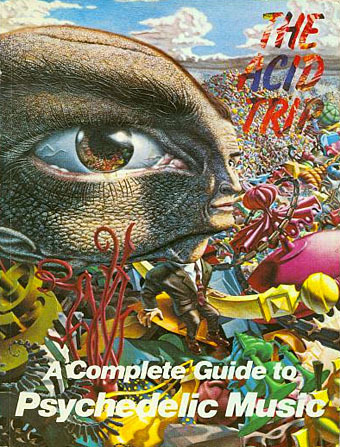
Previously on { feuilleton }
• The art of Mati Klarwein, 1932–2002
• The art of LSD
May 17, 2011
Signals from Mars
Raymond Taylor's composition, A Signal from Mars (1901).
This sheet music cover turned up recently as one of the pieces of science fiction-related graphics which will be on display at the British Library's Out of this World: Science Fiction but not as you know it exhibition when it opens on Thursday. I don't know what the music sounds like but the design is very familiar from a reworked version used for the cover of A Beacon from Mars, the second album by psychedelic band Kaleidoscope. It was always obvious that this cover had been copied from somewhere but I hadn't seen the original until now. On the reissue CD there are no design credits so I've no idea who drew the cover; given its rather crude felt-tipped appearance that may be just as well. It's a nice idea but poorly rendered.
A Beacon from Mars (1968) by Kaleidoscope.
There are two Kaleidoscopes among the psychedelic groups of the late 60s so it should be emphasised that it's the American one we're discussing here. The UK group were very good, especially on their second album, Faintly Blowing (1969), but the US band are in a different league altogether. I'd rate them as highly as any other group you care to name from the period 1967–69, including The Beatles. A troupe of formidable multi-instrumentalists, they started out as the Baghdad Blues Band (the name change was prompted by their manager), and played a unique blend of psych-rock, blues, bluegrass, English folk and Middle Eastern instrumentals. Jimmy Page called them his favourite band of all time, and it's notable that Led Zeppelin adopted a similarly eclectic formula shortly after. The last of Kaleidoscope's trio of 60s albums is aptly titled Incredible; the standout piece on that album is Seven-Ate Sweet which can be heard in its full 11-minute glory here. For more about the band, this fan site is the place to go.
Previously on { feuilleton }
• Design as virus #13: Tsunehisa Kimura
• Design as virus #11: Burne Hogarth
May 16, 2011
A Book of Images by WT Horton
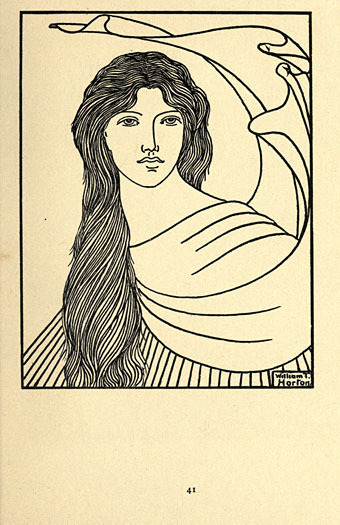
Diana.
A Book of Images is an odd volume, a small collection of full-page drawings published by the Unicorn Press in 1898. William Thomas Horton (1864–1919) wasn't in the first rank of black-and-white artists (although he did do better than this later on) but he was fortunate to have his book introduced by WB Yeats who generously lists the artist among some of the great talents of the 1890s. The series evolves from mundane views to mystical vision, and it's this latter quality which Horton would explore in subsequent works.
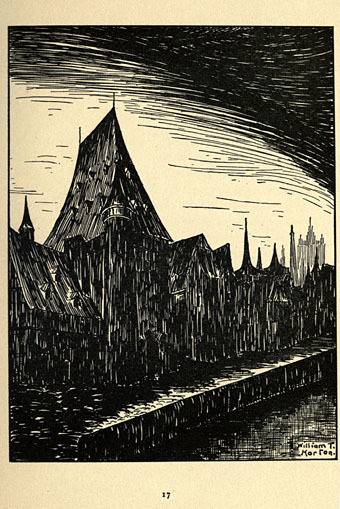
By the canal.
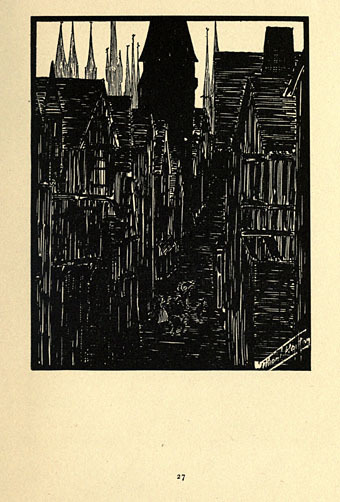
La Rue des Petit-Toits.
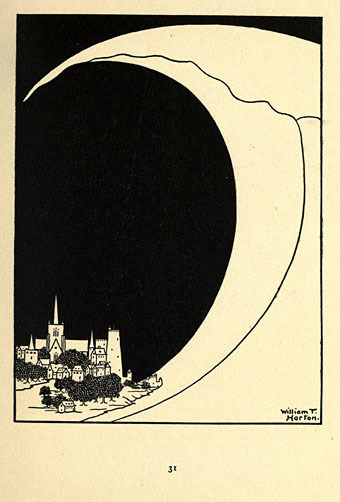
The Wave.
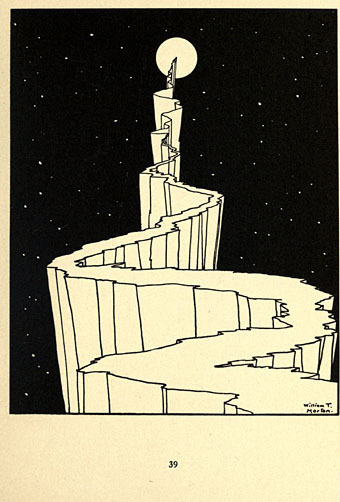
The Path to the Moon.
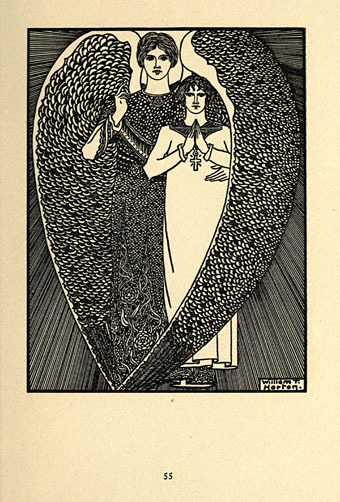
Ascending into Heaven.
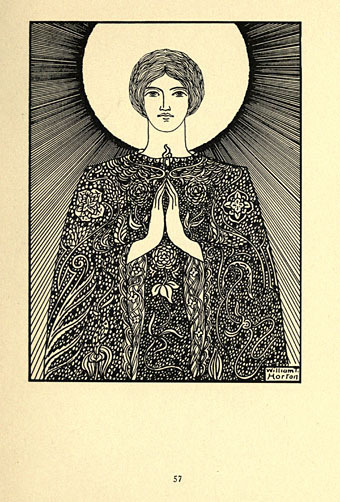
Rosa Mystica.
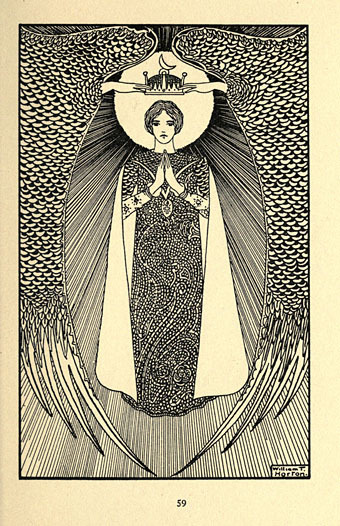
Assumptio.
Elsewhere on { feuilleton }
• The illustrators archive
Previously on { feuilleton }
• The Sapphire Museum of Magic and Occultism
John Coulthart's Blog
- John Coulthart's profile
- 31 followers





